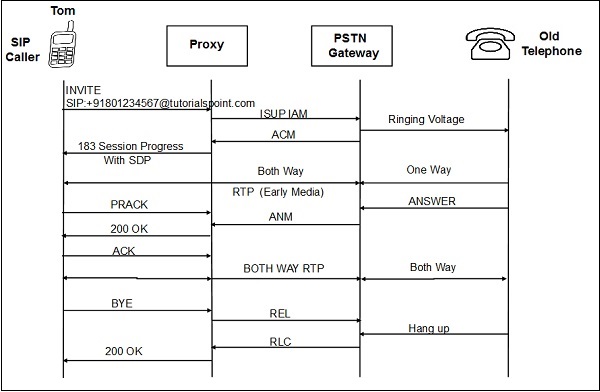
SIP to PSTN
SIP (Softphone) and PSTN (Old telephone) both are different networks and speaks different languages. So we need a translator (Gateway here) to communicate between these two networks.
Let us take an example to show how a SIP phone places a telephone call to a PSTN through PSTN gateway.
In this example, Tom (sip:tom@tutorialspoint.com) is a sip phone and Jerry uses a global telephone number +91401234567.
SIP to PSTN through Gateways
The following illustration shows a call flow from SIP to PSTN through gateways.

Given below is a step-by-step explanation of all the process that takes place while placing a call from a SIP phone to PSTN.
First of all, (Tom)SIP phone dials the global number +91401234567 to reach Jerry. SIP user agent understands it as a global number and converts it into request-uri using DNS and trigger the request.
The SIP phone sends the INVITE directly to gateway.
The gateway initiates the call into the PSTN by selecting an SS7 ISUP trunk to the next telephone switch in the PSTN.
The dialled digits from the INVITE are mapped into the ISUP IAM. The ISUP address complete message (ACM) is sent back by the PSTN to indicate that the trunk has been created.
The telephone generates ringtone and it goes to telephone switch. The gateway maps the ACM to the 183 Session Progress response containing an SDP indicating the RTP port that the gateway will use to bridge the audio from the PSTN.
Upon reception of the 183, the callers UAC begins receiving the RTP packets sent from the gateway and presents the audio to the caller so they know that the callee progressing in the PSTN.
The call completes when the called party answers the telephone, which causes the telephone switch to send an answer message (ANM) to the gateway.
The gateway then cuts the PSTN audio connection through in both directions and sends a 200 OK response to the caller. As the RTP media path is already established, the gateway replies the SDP in the 183 but causes no changes to the RTP connection.
The UAC sends an ACK to complete the SIP signalling exchange. As there is no equivalent message in ISUP, the gateway absorbs the ACK.
The caller sends BYE to gateway to terminates. The gateway maps the BYE into the ISUP release message (REL).
The gateway sends the 200OK to the BYE and receives an RLC from the PSTN.